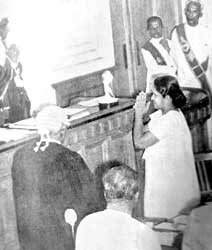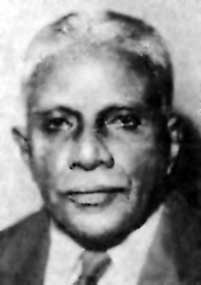When Sri Lanka gained independence, the country had a bicameral legislature. Members of Parliament were elected to the Lower House or the House of Representatives (95 plus 6 nominated MPs). The Upper House comprising 30 members was known as the Senate. Fifteen Senators were elected by the House of Representatives and the other fifteen were nominated by the government. Members served six-year terms.
 |
| Senate President, Sir Cyril de Zoysa greets Mrs. Bandaranaike after she was sworn in as a Senator. |
History was created when in July 1960, a Senator was appointed Prime Minister of
Sri Lanka. The leader of the party winning the largest number of seats at a general election was traditionally invited to form the government.
The situation was different in July 1960.
Mrs. Sirimavo Bandaranaike had led the Sri Lanka Freedom Party (SLFP) at the general election but she did not contest a seat. When the party won 75 seats it had got a clear majority and the leader was invited to form the government.
While Mrs. Bandaranaike was sworn in as Prime Minister on July 21, 1960 and became the world's first woman prime minister, she was appointed to the Senate on August 5. For the first time a member of the Senate had become the country's Prime Minister. She held the post until March 1965.
She decided to contest the Attanagalla seat (held by her husband for many years before he was assassinated) at the 1965 general election, which she won comfortably, recording a majority of 16,535 votes. Her party however, could not gain a majority. She thus sat in the House of Representatives for the first time as MP for Attanagalla and Leader of the Opposition.
Colombo port nationalised
The election of the Mahajana Eksath Peramuna (MEP) government in April 1956, under the leadership of S. W. R. D. Bandaranaike saw socialist policies being adopted.
The government took steps to expand the role of the public sector in the economy. The state sector was given more responsibility in managing industrial ventures and administering services which affected the masses. Nationalisation became the order of the day.
The State Industrial Corporations Act was introduced in 1957, one year after the new government was formed. August 1, 1958 marked the nationalisation of the port of Colombo. Bus services were also nationalised.
A one cent increase in train fares
The increase of train fares by one cent may sound absurd today. But this really happened on August 1, 1953. Several price increases were announced on that day and among the increases was the rise in train fares by one cent per mile.
Railway season tickets were increased by 25% while electricity charges were increased by 25%. Telephone charges rose by 5 cents.
Labour leader dies
Pioneer labour leader
A. E. Goonesinghe (1891-1967) died 41 years ago – on August 1, 1967.
Alexander Ekanayake Goonesinghe is credited with forming the first trade unions.
The first strikes were also organised by him in the 1920s. After forming the Ceylon Labour Union in 1922, he later formed the Ceylon Labour Party in 1929.
Having got himself elected to the State Council in 1931, he contested the first parliamentary elections in 1947 and was elected to the House of Representatives in 1947.
He joined the D S Senanayake Cabinet and served as minister of Labour & Social Services.
He was later sent as Ambassador to Indonesia and Burma'
Goonesinghe's influence as a trade union leader began to slip away when the leftist parties became active in the trade union field. |


